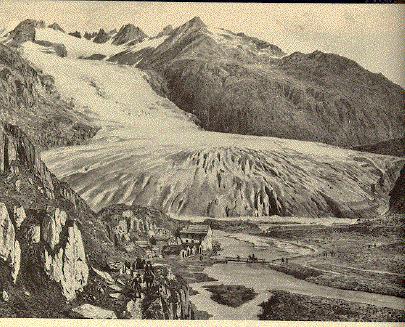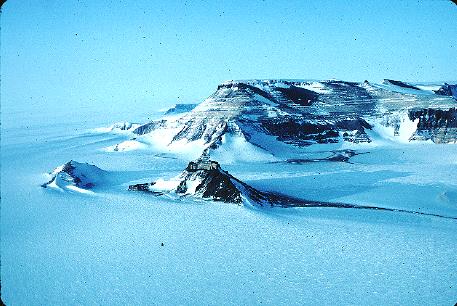

Rhone Glacier in Switzerland in the early 1800's, during the Little Ice Age. Today it is has retreated far up the mountain.
In this class we will follow two lines of thought, blending scientific inquiry with a bit of the sociology and philosophy of science.
The first line of thought relates to how science works. How do scientific ideas or "paradigms" come to be accepted by groups of scientists, and how do those paradigms actually guide the way scientists think about the world? Paradigms can change, sometimes very suddenly, leading to whole new ways of thinking about the natural world.
In the second line of thought, you will investigate glaciers and giant ice sheets, using scientific ideas about glaciers to illustrate the concepts of paradigms and paradigm shifts. What are glaciers, and how have they been viewed over the centuries?
Glaciers are bodies of ice that form from snowfall, and flow downhill under the pull of gravity. But scientists have not always agreed on this. We will explore how glaciers work, and you will learn about glaciers in Washington and the world.
Twenty thousand years ago, huge glaciers and continental sized ice sheets covered much of Europe and North America. For the past 2 million years, the ice has advanced and covered these areas every 100,000 years or so. Scientists didn't always agree about this either. We will explore the discoveries and ideas that lead to today's paradigm of Ice Age cycles. Greenland and Antarctica are still covered by giant glaciers. You will discover how to read the ancient record of the atmosphere and climate trapped inside glaciers, and the record of glaciation locked in sediments on the ocen floor.
Today, glaciers form the most dynamic and rapidly-changing solid surfaces on the planet. Melting glaciers are a primary cause of rising sea level today. Most scientists agree that the melting will continue with human-caused climate warming.
Classes will include group discussions about assigned readings and other source material.
In the lab, you will form groups to investigate how glaciers work. You will examine environments changed by the ice, and you will evaluate the potential impacts of glaciers on our future world. There will be 2 field trips during Lab periods to see how glaciers have changed Seattle.
There will be an all-day FIELD TRIP to a glacier on Mt Baker on Sunday October 1.
NO PREREQUISITES

Glaciers from the East Antarctic Ice Sheet flow through the Transantarctic Mountains to the Ross Sea.
Instructor: Ed Waddington (Geophysics) edw@geophys.washington.edu
Teaching Assistant: Tom Neumann (Geophysics) taneuman@geophys.washington.eduClass members